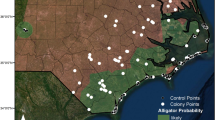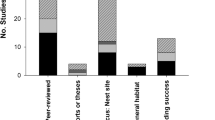Abstract
Fluctuations in size and turnover of centralized, aggregative breeding locations are attributable to both natural and anthropogenic causes, and distinguishing between these sources is critical for successful conservation and management of colonially breeding animals. We used a 40-year data set to examine the relative importance of colony variables to colony dynamics of endangered Wood Storks (Mycteria americana) within the United States. Larger colonies were less prone to abandonment and those of greater longevity were more likely to re-colonize, suggesting size and previous history have intrinsic value to Wood Storks. Colonies with a higher degree of physical connection to the mainland were more likely to be abandoned, probably because the isolation reduces access for mammalian nest predators. Proximity to human activity was positively related to the probability of re-colonization, indicating either that Wood Storks and humans are attracted to similar ecological features, or that there may be some positive benefit from nesting near human activities. Local rainfall in the 12 months prior to nest initiation was positively related to re-colonization rates and negatively related to extinction rates, suggesting that colony-site effects on persistence are mediated by annual weather patterns. Our findings present means to prioritize conservation efforts for colonial nesting waterbirds.

Similar content being viewed by others
References
Ainley DG, Ribic CA, Ballard G, Heath S, Gaffney I, Karl BJ, Barton KJ, Wilson PR, Webb S (2004) Geographic structure of Adelie Penguin populations: overlap in colony-specific foraging areas. Ecological Monographs 74:159–178
Barbraud C, Nichols JD, Hines JE, Hafner H (2003) Estimating rates of local extinction and colonization in colonial species and an extension to the metapopulation and community levels. Oikos 101:113–126
Bled F, Royle JA, Cam E (2011) Assessing hypotheses about nesting site occupancy dynamics. Ecology 92:938–951
Borkhataria RR (2009) Modeling population viability and habitat suitability for the endangered wood stork (Mycteria americana) in the southeastern United States. Dissertation, University of Florida, Gainesville
Borkhataria RR, Frederick PC, Keller RA, Collazo JA (2012) Temporal variation in local wetland hydrology influences postdispersal survival of juvenile Wood Storks (Mycteria americana). The Auk 129:438–448
Bouchard S, Bjorndal KA (2000) Sea turtles as biological transporters of nutrients and energy from marine to terrestrial ecosystems. Ecology 81:2305–2313
Bouton SN, Frederick PC, Rocha CD, Barbosa Dos Santos AT, Bouton TC (2005) Effects of tourist disturbance on Wood Stork nesting success and breeding behavior in the Brazilian Pantanal. Waterbirds 28:487–497
Brooks WB, Dean T (2008) Measuring the biological status of the U. S. breeding population of Wood Storks. Waterbirds 31:50–62
Bryan AL Jr, Coulter MC (1987) Foraging flight characteristics of Wood Storks in east-central Georgia, USA. Colonial Waterbirds 10:157–161
Bryan AL Jr, Robinette JR (2008) Breeding success of Wood Storks nesting in Georgia and South Carolina. Waterbirds 31:19–24
Bryan AL Jr, Coulter MC, Pennycuick CJ (1995) Foraging strategies and energetic costs of foraging flights by breeding wood storks. The Condor 97:133–140
Buckley PA, Buckley FG (2000) Patterns of colony-site use and disuse in saltmarsh-nesting Common and Roseate Terns. Journal of Field Ornithology 71:356–369
Burnham KP, Anderson DR (2002) Model selection and multimodel inference: a practical information-theoretic approach. Springer Verlag, New York
Burtner BF (2011) Symbiosis between long-legged wading birds (Ciconiiformes) and alligators (Alligator mississippiensis)? Testing the “nest protector” hypothesis. Thesis, University of Florida, Gainesville
Bustnes JO, Miland O, Fjeld M, Erikstad KE, Skaare JU (2005) Relationships between ecological variables and four organochlorine pollutants in an artic glaucous gull (Larus hyperboreus) population. Environmental Pollution 136:175–185
Corkeron PJ, Connor R (1999) Why do baleen whales migrate? Marine Mammal Science 15:1228–1245
Coulter MC, Bryan AL Jr (1995) Factors affecting reproductive success of Wood Storks (Mycteria americana) in east-central Georgia. The Auk:237–243
Coulter MC, Rodgers JA Jr, Ogden JC, Depkin FC (1999) Wood Stork (Mycteria americana). The Birds of North America:24
Crooks KR, Soulé ME (1999) Mesopredator release and avifaunal extinctions in a fragmented landscape. Nature 400:563–566
Danchin E, Wagner RH (1997) The evolution of coloniality: the emergence of new perspectives. Trends in Ecology and Evolution 12:342–347
Delgado MM, Ratikainen II, Kokko H (2011) Inertia: the discrepancy between individual and common good in dispersal and prospecting behaviour. Biological Reviews 86:717–732
Dorn NJ, Trexler JC (2007) Crayfish assemblage shifts in a large drought-prone wetland: the roles of hydrology and competition. Freshwater Biology 52:2399–2411
Dutton DL, Dutton PH, Chaloupka M, Bouton RH (2005) Increase of a Caribbean leatherback turtle Dermochelys coriacea nesting population linked to long-term nest protection. Biological Conservation 126:186–194
Eason P, Rabea B, Attum O (2012) Island shape, size, and isolation affect nest-site selection by little terns. Journal of Field Ornithology 83:372–380
Erwin RM, Nichols JD, Eyler TB, Stotts DB, Truitt BR (1998) Modeling colony-site dynamics: a case study of gull-billed terns (Sterna nilotica) in coastal Virginia. The Auk:970–978
Frederick PC, Meyer KD (2008) Longevity and size of Wood Stork (Mycteria americana) colonies in Florida as guides for an effective monitoring strategy in the southeastern United States. Waterbirds 31:12–18
Frederick PC, Powell GVN III (1994) Nutrient transport by wading birds in the Everglades. In: Davis SM, Ogden JC (eds) Everglades: the ecosystem and its restoration. St. Lucie Press, Delray Beach
Fryxell JM, Greever J, Sinclair ARE (1988) Why are migratory ungulates so abundant? American Naturalist 131:781–798
Gaines KF, Bryan AL Jr, Dixon PM, Harris MJ (1998) Foraging habitat use by Wood Storks nesting in the coastal zone of Georgia, USA. Colonial Waterbirds 21:43–52
Ganter B, Cooke F (1998) Colonial nesters in a deteriorating habitat: site fidelity and colony dynamics of lesser snow geese. The Auk 115:642–652
Gawlik DE (2002) The effects of prey availability on the numerical response of wading birds. Ecological Monographs 72:329–346
Herring HK, Gawlik DE (2011) Resource selection functions for Wood Stork foraging habitat in the southern Everglades. Waterbirds 34:133–142
Kahl MP (1964) Food ecology of the wood stork (Mycteria americana) in Florida. Ecological Monographs 34:98–117
Kajzer J, Lenda M, Kosmicki A, Bobrek R, Kowalczyk T, Martyka R, Skorka P (2012) Patch occupancy and abundance of local populations in landscapes differing in degree of habitat fragmentation: a case study of the colonial Black-headed Gull, Chroicocephalus ridibundus. Journal of Biogeography 39:371–381
Kim S-Y, Torres R, Drummond H (2009) Simultaneous positive and negative density-dependent dispersal in a colonial bird species. Ecology 90:230–239
Kushlan JA, Frohring PC (1986) The history of the southern Florida Wood Stork population. The Wilson Bulletin:368–386
Li W, Li L, Fu R, Deng L, Wang H (2011) Changes to the north atlantic subtropical high and its role in the intensification of summer rainfall variability in the southeastern United States. Journal of Climate 24:1499–1506
Loeb SC, Pepper WD, Doyle AT (1992) Habitat characteristics of active and abandoned Red-cockaded Woodpecker colonies. Southern Journal of Applied Forestry 16:120–125
Lombard CD, Collazo JA, McNair DB (2010) Nest and chick survival and colony-site dynamics of least terns in the U. S. Virgin Islands. The Condor 112:56–64
Loye JE, Carroll SP (1998) Ectoparasite behavior and its effects on avian nest site selection. Annals of the Entomological Society of America 91:159–163
McChesney GJ, Tershy BR (1998) History and status of introduced mammals and impacts to breeding seabirds on the California Channel and northwestern Baja California Islands. Colonial Waterbirds 21:335–347
McClenachan L, Jackson JBC, Newman MJH (2006) Conservation implications of historic sea turtle nesting beach loss. Frontiers in Ecology and the Environment 4:290–296
Misra V, Carlson E, Craig RK, Enfield D, Kirtman B, Landing W, Lee S-K, Letson D, Marks F, Obeysekera J, Powell M, Shin S-l (2011) Climate scenarios: a Florida-Centric view. Florida Climate Change Task Force, Available online at http://floridaclimate.org/whitepapers/
Moilanen A, Nieminen M (2002) Simple connectivity measures in spatial ecology. Ecology 83:1131–1145
Møller AP (2008) Flight distance and population trends in European breeding birds. Behavioral Ecology 19:1095–1102
Murphy TM, Coker JW (2008) A twenty-six year history of Wood Stork nesting in South Carolina. Waterbirds 31:3–7
Murray NM (2009) Foraging behavior and success of Australian White Ibis (Threskiornis mollucca) in an urban environment. Notornis 56:201–205
Naiman RJ, Bilby RE, Schindler DE, Helfield JM (2002) Pacific salmon, nutrients, and the dynamics of freshwater and riparian ecosystems. Ecosystems 5:399–417
Nell LA, Frederick PC, Mazzotti FJ, Vliet KA, Brandt LA (2016) Presence of breeding birds improves body condition for a crocodilian nest protector. PloS One 11, e0149572
Ogden JC (1994) A comparison of wading bird nesting colony dynamics (1931–1946 and 1974–1989) as an indication of ecosystem conditions in the southern Everglades. In: Davis S, Ogden JC (eds) Everglades: the ecosystem and its restoration. St. Lucie Press, Delray Beach, pp 533–570
Ogden JC, McCrimmon DA Jr, Bancroft GT, Patty BW (1987) Breeding populations of the wood stork in the southeastern United States. The Condor:752–759
Orlowski G, Czapulak A (2007) Different extinction risks of the breeding colonies of Rooks Corvus frugilegus in rural and urban areas of SW Poland. Acta Ornithologica 42:145–155
Oro D (2003) Managing seabird metapopulations in the Mediterranean: constraints and challenges. Scientia Marina 67:13–22
Ramo C, Busto B (1992) Nesting failure of the wood stork in a neotropical wetland. The Condor 94:777–781
Robertson GJ, Gilchrist HG, Mallory ML (2007) Colony dynamics and persistence of Ivory Gull breeding in Canada. Avian Conservation and Ecology 2, Art 8, [online] URL: http://www.ace-eco.org/vol2/iss2/art8/
Rodgers JA Jr (1987) On the antipredator advantages of coloniality: a word of caution. The Wilson Bulletin 99:269–271
Rodgers JA Jr, Schwikert ST (1997) Breeding success and chronology of Wood Storks Mycteria americana in northern and central Florida, USA. Ibis 139:76–91
Rodgers JA Jr, Schwikert ST (2002) Buffer zone distances to protect foraging and loafing waterbirds from disturbance by personal watercraft and outboard powered boats. Conservation Biology 16:216–224
Ruetz CR, Trexler JC, Jordan F, Loftus WF, Perry SA (2005) Population dynamics of wetland fishes: spatio-temporal patterns synchronized by hydrological disturbance? Journal of Animal Ecology 74:322–332
Russell GJ, Rosales A (2010) Sociability leads to instability. Theoretical Ecology 3:3–12
Seager R, Tzanova A, Nakamura J (2009) Drought in the southeastern United States: causes, variability over the last millennium, and the potential for future hydroclimatic change. Journal of Climate 22:5021–5045
Shirai T (2013) Colony development and density-dependent processes in breeding Grey Herons. International Journal of Zoology. doi:10.1155/2013/404065
Sydeman WJ, Bradley RW, Warzybok P, Abraham CL, Jahncke J, Hyrenbach KD, Kousky V, Hipfner JM, Ohman MD (2006) Planktivorous auklet Ptychoramphus aleuticus responses to ocean climate, 2005: Unusual atmospheric blocking?. Geophysical Research Letters 33 doi:10.1029/2006GL026736
Tasker ML, Camphuysen CJ, Cooper J, Garthe S, Montevecchi WA, Blaber SJM (2000) The effects of fishing on marine birds. ICES Journal of Marine Science 57:531–547
Therneau TM (2015) A Package for Survival Analysis in S. version 2.38, http://CRAN.R-project.org/package=survival
Troëng S, Rankin E (2005) Long term conservation efforts contribute to positive green turtle Chelonia mydas nesting trend at Tortuguero, Costa Rica. Biological Conservation 121:111–116
White GC, Burnham KP (1999) Program MARK: survival estimation from populations of marked animals. Bird study 46:120–139
Wilson RP, Culik B, Danfeld R, Adelung D (1991) People in Antarctica--how much do Adélie Penguins Pygoscelis adeliae care? Polar Biology 11:363–370
Winn B, Swan D, Ozier J, Harris MJ (2008) Wood Stork nesting in Georgia: 1992–2005. Waterbirds 31:8–11
Acknowledgments
We are indebted to all the biologists (many retired) who helped us with buried records, notebooks and recollections. This paper is dedicated to the memory of John Ogden, who studied and conserved Wood Storks throughout his professional life. We are grateful to National Fish and Wildlife Foundation (2007-0017-000), Georgia Department of Natural Resources (00076801; 00076802), South Florida Water Management District (4500014203), and Felburn Foundation (00073200) for financial support.
Author information
Authors and Affiliations
Corresponding author
Rights and permissions
About this article
Cite this article
Tsai, JS., Reichert, B.E., Frederick, P.C. et al. Breeding Site Longevity and Site Characteristics Have Intrinsic Value for Predicting Persistence of Colonies of an Endangered Bird. Wetlands 36, 639–647 (2016). https://doi.org/10.1007/s13157-016-0774-3
Received:
Accepted:
Published:
Issue Date:
DOI: https://doi.org/10.1007/s13157-016-0774-3




